Renato Vukovic
Emotionally Intelligent Task-oriented Dialogue Systems: Architecture, Representation, and Optimisation
Jul 02, 2025Abstract:Task-oriented dialogue (ToD) systems are designed to help users achieve specific goals through natural language interaction. While recent advances in large language models (LLMs) have significantly improved linguistic fluency and contextual understanding, building effective and emotionally intelligent ToD systems remains a complex challenge. Effective ToD systems must optimise for task success, emotional understanding and responsiveness, and precise information conveyance, all within inherently noisy and ambiguous conversational environments. In this work, we investigate architectural, representational, optimisational as well as emotional considerations of ToD systems. We set up systems covering these design considerations with a challenging evaluation environment composed of a natural-language user simulator coupled with an imperfect natural language understanding module. We propose \textbf{LUSTER}, an \textbf{L}LM-based \textbf{U}nified \textbf{S}ystem for \textbf{T}ask-oriented dialogue with \textbf{E}nd-to-end \textbf{R}einforcement learning with both short-term (user sentiment) and long-term (task success) rewards. Our findings demonstrate that combining LLM capability with structured reward modelling leads to more resilient and emotionally responsive ToD systems, offering a practical path forward for next-generation conversational agents.
Learning from Noisy Labels via Self-Taught On-the-Fly Meta Loss Rescaling
Dec 17, 2024Abstract:Correct labels are indispensable for training effective machine learning models. However, creating high-quality labels is expensive, and even professionally labeled data contains errors and ambiguities. Filtering and denoising can be applied to curate labeled data prior to training, at the cost of additional processing and loss of information. An alternative is on-the-fly sample reweighting during the training process to decrease the negative impact of incorrect or ambiguous labels, but this typically requires clean seed data. In this work we propose unsupervised on-the-fly meta loss rescaling to reweight training samples. Crucially, we rely only on features provided by the model being trained, to learn a rescaling function in real time without knowledge of the true clean data distribution. We achieve this via a novel meta learning setup that samples validation data for the meta update directly from the noisy training corpus by employing the rescaling function being trained. Our proposed method consistently improves performance across various NLP tasks with minimal computational overhead. Further, we are among the first to attempt on-the-fly training data reweighting on the challenging task of dialogue modeling, where noisy and ambiguous labels are common. Our strategy is robust in the face of noisy and clean data, handles class imbalance, and prevents overfitting to noisy labels. Our self-taught loss rescaling improves as the model trains, showing the ability to keep learning from the model's own signals. As training progresses, the impact of correctly labeled data is scaled up, while the impact of wrongly labeled data is suppressed.
Local Topology Measures of Contextual Language Model Latent Spaces With Applications to Dialogue Term Extraction
Aug 07, 2024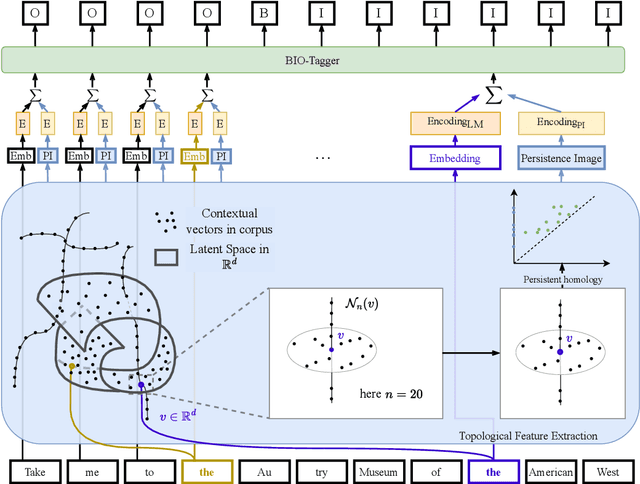

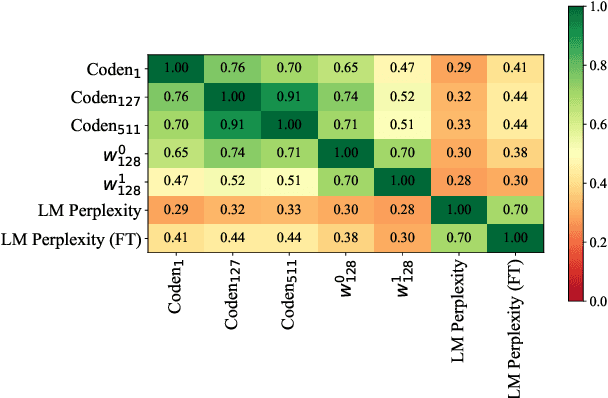

Abstract:A common approach for sequence tagging tasks based on contextual word representations is to train a machine learning classifier directly on these embedding vectors. This approach has two shortcomings. First, such methods consider single input sequences in isolation and are unable to put an individual embedding vector in relation to vectors outside the current local context of use. Second, the high performance of these models relies on fine-tuning the embedding model in conjunction with the classifier, which may not always be feasible due to the size or inaccessibility of the underlying feature-generation model. It is thus desirable, given a collection of embedding vectors of a corpus, i.e., a datastore, to find features of each vector that describe its relation to other, similar vectors in the datastore. With this in mind, we introduce complexity measures of the local topology of the latent space of a contextual language model with respect to a given datastore. The effectiveness of our features is demonstrated through their application to dialogue term extraction. Our work continues a line of research that explores the manifold hypothesis for word embeddings, demonstrating that local structure in the space carved out by word embeddings can be exploited to infer semantic properties.
Infusing Emotions into Task-oriented Dialogue Systems: Understanding, Management, and Generation
Aug 05, 2024

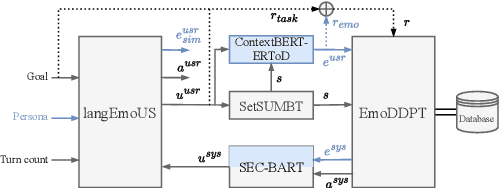
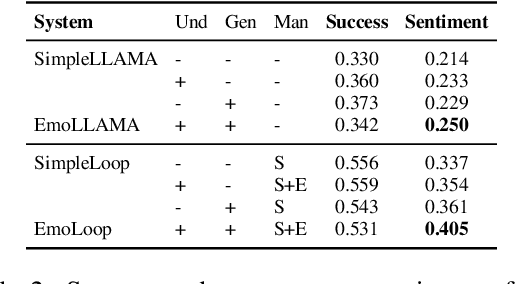
Abstract:Emotions are indispensable in human communication, but are often overlooked in task-oriented dialogue (ToD) modelling, where the task success is the primary focus. While existing works have explored user emotions or similar concepts in some ToD tasks, none has so far included emotion modelling into a fully-fledged ToD system nor conducted interaction with human or simulated users. In this work, we incorporate emotion into the complete ToD processing loop, involving understanding, management, and generation. To this end, we extend the EmoWOZ dataset (Feng et al., 2022) with system affective behaviour labels. Through interactive experimentation involving both simulated and human users, we demonstrate that our proposed framework significantly enhances the user's emotional experience as well as the task success.
Dialogue Ontology Relation Extraction via Constrained Chain-of-Thought Decoding
Aug 05, 2024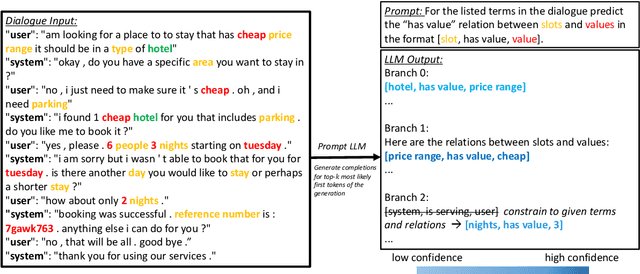

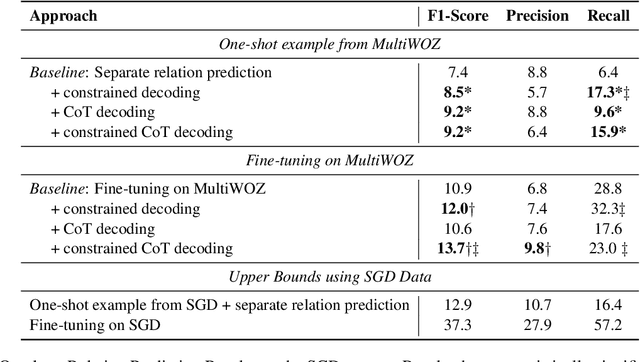
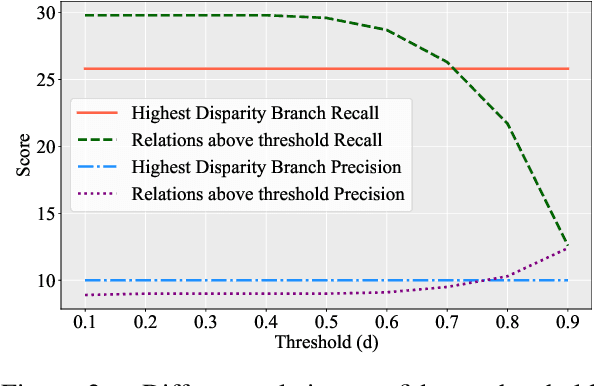
Abstract:State-of-the-art task-oriented dialogue systems typically rely on task-specific ontologies for fulfilling user queries. The majority of task-oriented dialogue data, such as customer service recordings, comes without ontology and annotation. Such ontologies are normally built manually, limiting the application of specialised systems. Dialogue ontology construction is an approach for automating that process and typically consists of two steps: term extraction and relation extraction. In this work, we focus on relation extraction in a transfer learning set-up. To improve the generalisation, we propose an extension to the decoding mechanism of large language models. We adapt Chain-of-Thought (CoT) decoding, recently developed for reasoning problems, to generative relation extraction. Here, we generate multiple branches in the decoding space and select the relations based on a confidence threshold. By constraining the decoding to ontology terms and relations, we aim to decrease the risk of hallucination. We conduct extensive experimentation on two widely used datasets and find improvements in performance on target ontology for source fine-tuned and one-shot prompted large language models.
CAMELL: Confidence-based Acquisition Model for Efficient Self-supervised Active Learning with Label Validation
Oct 13, 2023Abstract:Supervised neural approaches are hindered by their dependence on large, meticulously annotated datasets, a requirement that is particularly cumbersome for sequential tasks. The quality of annotations tends to deteriorate with the transition from expert-based to crowd-sourced labelling. To address these challenges, we present \textbf{CAMELL} (Confidence-based Acquisition Model for Efficient self-supervised active Learning with Label validation), a pool-based active learning framework tailored for sequential multi-output problems. CAMELL possesses three core features: (1) it requires expert annotators to label only a fraction of a chosen sequence, (2) it facilitates self-supervision for the remainder of the sequence, and (3) it employs a label validation mechanism to prevent erroneous labels from contaminating the dataset and harming model performance. We evaluate CAMELL on sequential tasks, with a special emphasis on dialogue belief tracking, a task plagued by the constraints of limited and noisy datasets. Our experiments demonstrate that CAMELL outperforms the baselines in terms of efficiency. Furthermore, the data corrections suggested by our method contribute to an overall improvement in the quality of the resulting datasets.
From Chatter to Matter: Addressing Critical Steps of Emotion Recognition Learning in Task-oriented Dialogue
Aug 24, 2023Abstract:Emotion recognition in conversations (ERC) is a crucial task for building human-like conversational agents. While substantial efforts have been devoted to ERC for chit-chat dialogues, the task-oriented counterpart is largely left unattended. Directly applying chit-chat ERC models to task-oriented dialogues (ToDs) results in suboptimal performance as these models overlook key features such as the correlation between emotions and task completion in ToDs. In this paper, we propose a framework that turns a chit-chat ERC model into a task-oriented one, addressing three critical aspects: data, features and objective. First, we devise two ways of augmenting rare emotions to improve ERC performance. Second, we use dialogue states as auxiliary features to incorporate key information from the goal of the user. Lastly, we leverage a multi-aspect emotion definition in ToDs to devise a multi-task learning objective and a novel emotion-distance weighted loss function. Our framework yields significant improvements for a range of chit-chat ERC models on EmoWOZ, a large-scale dataset for user emotion in ToDs. We further investigate the generalisability of the best resulting model to predict user satisfaction in different ToD datasets. A comparison with supervised baselines shows a strong zero-shot capability, highlighting the potential usage of our framework in wider scenarios.
EmoUS: Simulating User Emotions in Task-Oriented Dialogues
Jun 02, 2023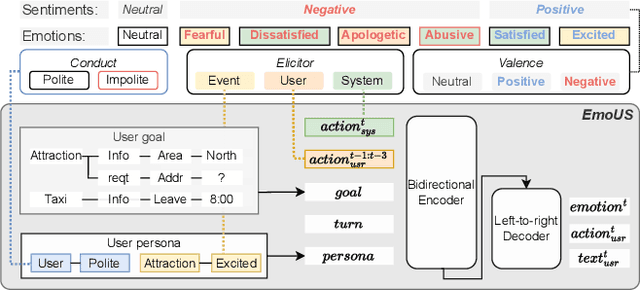
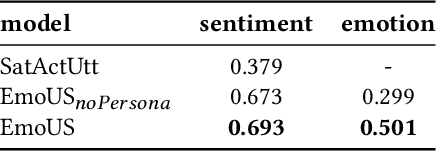


Abstract:Existing user simulators (USs) for task-oriented dialogue systems only model user behaviour on semantic and natural language levels without considering the user persona and emotions. Optimising dialogue systems with generic user policies, which cannot model diverse user behaviour driven by different emotional states, may result in a high drop-off rate when deployed in the real world. Thus, we present EmoUS, a user simulator that learns to simulate user emotions alongside user behaviour. EmoUS generates user emotions, semantic actions, and natural language responses based on the user goal, the dialogue history, and the user persona. By analysing what kind of system behaviour elicits what kind of user emotions, we show that EmoUS can be used as a probe to evaluate a variety of dialogue systems and in particular their effect on the user's emotional state. Developing such methods is important in the age of large language model chat-bots and rising ethical concerns.
ChatGPT for Zero-shot Dialogue State Tracking: A Solution or an Opportunity?
Jun 02, 2023
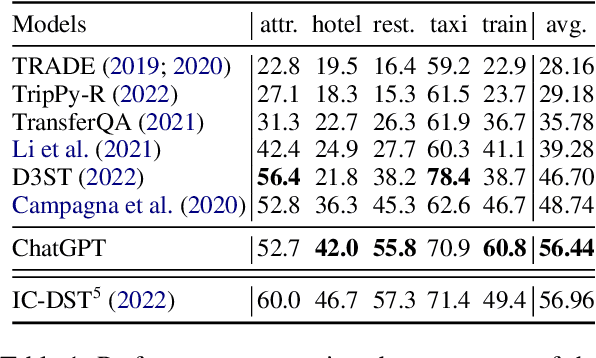
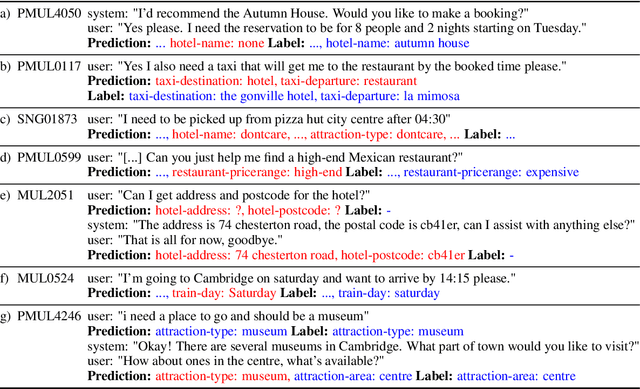
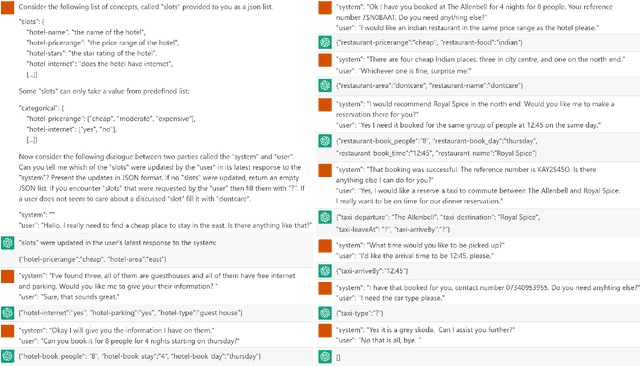
Abstract:Recent research on dialogue state tracking (DST) focuses on methods that allow few- and zero-shot transfer to new domains or schemas. However, performance gains heavily depend on aggressive data augmentation and fine-tuning of ever larger language model based architectures. In contrast, general purpose language models, trained on large amounts of diverse data, hold the promise of solving any kind of task without task-specific training. We present preliminary experimental results on the ChatGPT research preview, showing that ChatGPT achieves state-of-the-art performance in zero-shot DST. Despite our findings, we argue that properties inherent to general purpose models limit their ability to replace specialized systems. We further theorize that the in-context learning capabilities of such models will likely become powerful tools to support the development of dedicated and dynamic dialogue state trackers.
Dialogue Term Extraction using Transfer Learning and Topological Data Analysis
Aug 22, 2022
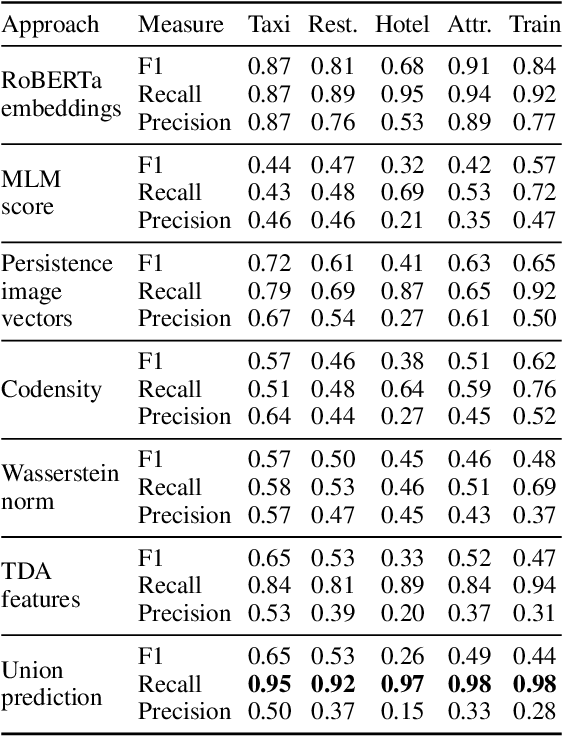

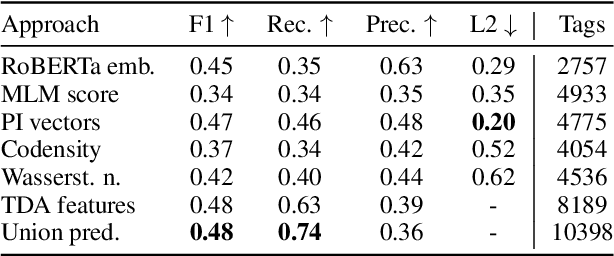
Abstract:Goal oriented dialogue systems were originally designed as a natural language interface to a fixed data-set of entities that users might inquire about, further described by domain, slots, and values. As we move towards adaptable dialogue systems where knowledge about domains, slots, and values may change, there is an increasing need to automatically extract these terms from raw dialogues or related non-dialogue data on a large scale. In this paper, we take an important step in this direction by exploring different features that can enable systems to discover realizations of domains, slots, and values in dialogues in a purely data-driven fashion. The features that we examine stem from word embeddings, language modelling features, as well as topological features of the word embedding space. To examine the utility of each feature set, we train a seed model based on the widely used MultiWOZ data-set. Then, we apply this model to a different corpus, the Schema-Guided Dialogue data-set. Our method outperforms the previously proposed approach that relies solely on word embeddings. We also demonstrate that each of the features is responsible for discovering different kinds of content. We believe our results warrant further research towards ontology induction, and continued harnessing of topological data analysis for dialogue and natural language processing research.
 Add to Chrome
Add to Chrome Add to Firefox
Add to Firefox Add to Edge
Add to Edge